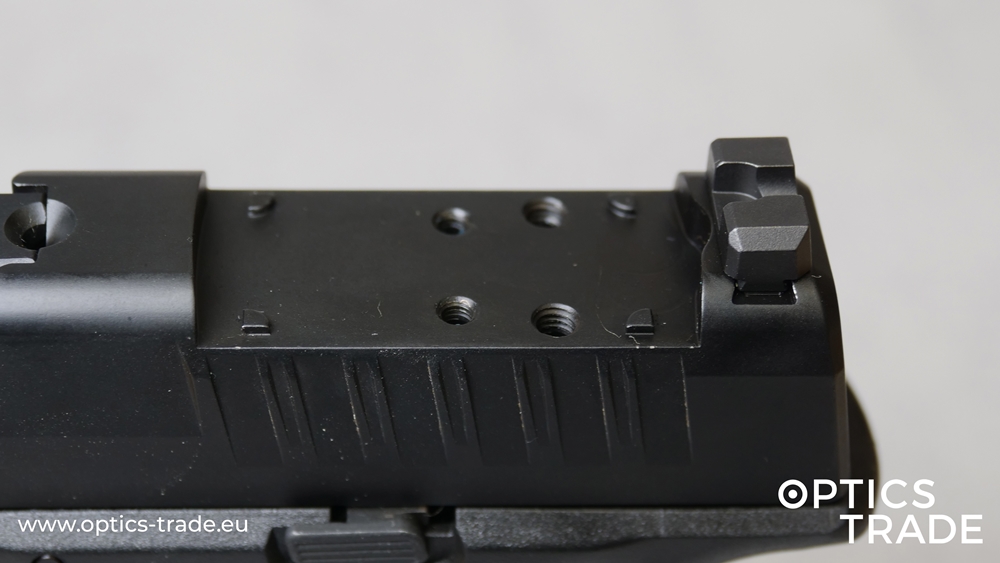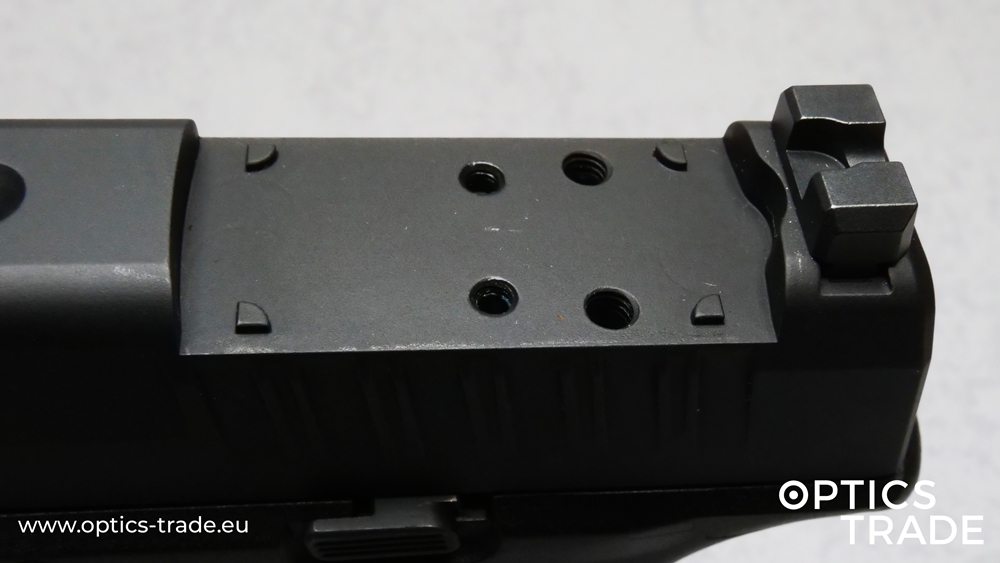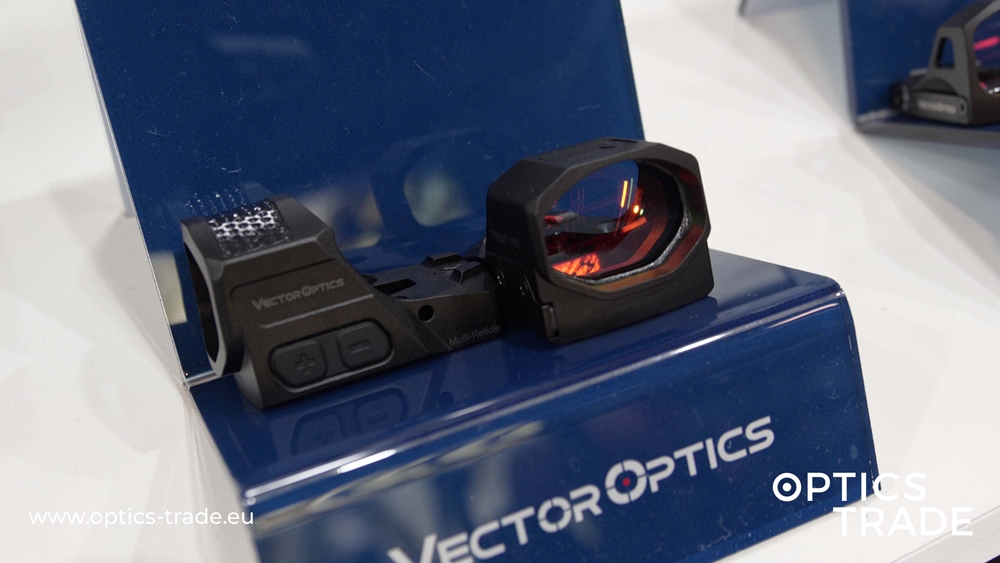Hello and welcome to another episode of Optics Trade Debates. We continue on our way through red dot sights that are available on our webpage. To be more specific, the topic of this debate will be primarily focused on reflex red dot sights.
Reflex red dots only have one lens in the front and a diode at the back. It’s this simplistic construction that justifies a separate category of red dot sights. When a person looks through it, they can see the red dot, nothing else stands in the way. Reflex red dots are considered as ‘open red dots’ since they are not closed on both sides. Even though nowadays some of them can be created closed on both sides, this build is rather unusual.
As you can see by looking at the examples shown in the video, there are many different sizes and form factors available in this subcategory of red dot sights.
The most common size of reflex red dots fits nicely between the thumb and the forefinger of one hand. A well-known brand that makes these types of reflex dots is Noblex (the company was formerly known as Docter). This is also why these reflex dots were commonly referred to as ‘docter dots’ in the past, no matter which company actually manufactured the optical piece at hand. These reflex dots are light and super easy to use. They are most commonly used on handguns but also work well on rifles.
But some of the reflex sights are much bigger, especially when it comes to those intended to be mounted on rifles exclusively. Take Meprolight, C-More or Holosun models, for example.
Lately, reflex dots can be also found on shotguns and suitable mounting solutions are available to keep up with this new trend. This is another reason to believe that this subcategory of red dot sights will become more and more popular.
As far as the sizes of the dot inside the device are concerned, there are some basic principles to follow. When it comes to shooting with a handgun or a rifle at close range, bigger dot sizes from 6 to 8 MOA are preferred. If you’re using it on a rifle and intended to shoot at longer ranges, 3 MOA red dot is the best option since it won’t cover as much of the target.
Let’s use a 3.5 MOA red dot for example on how to translate MOA into centimetres at 100m. That means it covers approximately 10 centimetres at 100 metres. 7 MOA in comparison covers 20 centimetres on 100 metres, so twice as much. Such big coverage is needed because with handguns, users are usually aren’t shooting beyond 25 metres maximum. That means that at 25 metres, it covers about 5 centimetres. Perfect for fast target acquisition and the red dot is steady as well. As a rule, bigger dots at close ranges are more appropriate.
It is, however, true that due to this simplistic design of these devices with an only single lens in front and a diode in the back, it’s really hard to produce red dots that would be smaller than 3 MOA. Only Shield Sights in Great Britain are currently producing 1 MOA dots. Every other producer makes 3 MOA dots and bigger.
Indeed, this is one of the main differences that separate reflex dot sights from the standard tube formats. Tube-sized red dots like Aimpoint and similar are easily made with smaller dot sizes such as 1 MOA.
It’s really easy to look through reflex dot sights using both eyes and all red dot sights in general. The magnification is usually 1x (as in, there is no image magnification) or just slightly above 1x (1.05x if you’re using one of the cheaper options on the market, for instance). The higher the quality of the dot, the less likely is there to be any magnification.
Let’s talk about the advantages and disadvantages of reflex dot sights. The biggest advantage lies in the fact that when a person looks through this kind of a red dot, it’s really hard to tell that they’re looking through an optical device at all. It’s almost the same as using a plain eye and with that, reflex red dots are incredibly intuitive to use.
If you look around the window, you can see that there isn’t a lot there, not much housing or excess material. This way, there is almost no obstruction of the field of view. This is a huge plus since most of the full-tube dots have a bulky housing with a small lens to look through.
The disadvantage is that they’re open. If it’s raining or snowing outside and water comes between the diode and the lens, it will block the optical path and the user won’t be able to see the red dot anymore. Droplets on the front lens, too, can obstruct our line of sight. This is something that you can avoid with full-tube sights.
Nowadays, some manufacturers like Steiner Optics also make enclosed reflex sights. That’s one solution to this problem – an additional glass that covers the LED diode and protects the device from the outside interference. Some red dots, like the Holosun model used in the video, have a small hole in the housing so that the water pours out instead of building up inside the device. Indeed, there are many different approaches to solving this issue.
Here, at Optics Trade, we believe that in the future most reflex red dots will be made with enclosed housing. However, it’s far more complicated and expensive to engineer a reflex sight like that.
Another thing we can notice while looking through a reflex sight is that there is some tint present. The yellow or blue tint of the lens is a rather common problem with these devices. Of course, red dot manufacturers wouldn’t refer to this occurrence as an issue but nevertheless, the user experience is better when there is no glass discolouration. With premium brands like Zeiss, there is no tint but let’s take C-More Railway Red Dot Sight or Meprolight Mepro M21 for example – the lens tint is quite obvious.
The reason behind the lens tint lies in the fact that the red beam of light has to reflect from the glass surface. The glass has a special coating that helps with that. Generally speaking, the resulting tint is not a real disadvantage. It’s not really likely that you’d be able to notice the tint while shooting, only when you’re looking directly at the lens up-close.
Moving on to the mounting of reflex sights. Most of these sights use very similar mounts. More than half of the industry uses the Docter standard with four pins and two screws that go through the housing first and then the mount. For example, companies like Meopta, Burris and some of Vortex and Delta Optical reflex dots are all compatible with this standard. Zeiss Compact-Point dots use a Zeiss plate, their own standard. It closely resembles the Docter standard but it’s not identical. The screws first enter through the plate and then the red dot, which is an uncommon sequence. C-More is another company that uses its own standard that is also used by other producers like Delta Optical and Shield Sights.
Plenty reflex sights are available for purchase with a Picatinny mount that can be later removed. Note that many of these sights are mounted on rifles and in Europe, the Picatinny standard is not as popular as in the US. On the Continent, Blaser, Sauer and various other rifles use their own standards that are not cross-brand compatible. For those rifles, there are many European manufacturers that produce mounts to accommodate different mounting standards.
We focused on rifles but the same can be said about handguns. In Europe, Henneberger mounts are the most popular. The German company produces many different mounting solutions for pistols and revolvers that can accommodate the Docter standard of mounting and with that, all reflex sights using the standard.
C-More also produces its own mounts that fit their standard. Shield Sights, too, has an entire line of mounts that work with their reflex sights. There are also certain aftermarket producers like Toni System that make mounts for the Docter, Shield and C-More standards. All in all, when it comes to mounts, there is really a diverse selection to pick from.
Another thing worth mentioning is that reflex sights usually feature screws for elevation adjustment instead of small turrets that can be found on tube sights.
Although the majority of red dots use the traditional red colour of illumination, new trends are diversifying the market. Since many people cannot see the colour red, new models with green or even gold illumination offer an easy solution for colour blind users as most retain blue-yellow discrimination. Companies that started the trend (like Holosun and Meprolight, for example) claim that even up to 20% of users cannot see red. That’s likely an exaggeration but even if just 10% of shooters are unable to see the colour red or their preferences lie outside of the standard, it’s good to know that the market has them covered.
This is everything we had in mind for this debate. Thank you for your attention. Please like and share this video if you found it useful. If you have any questions left, leave them in the comment section below or send us an email and we’ll be happy to answer. Subscribe to our Youtube channel for more content. We’ll see you next time.
Products mentioned:




